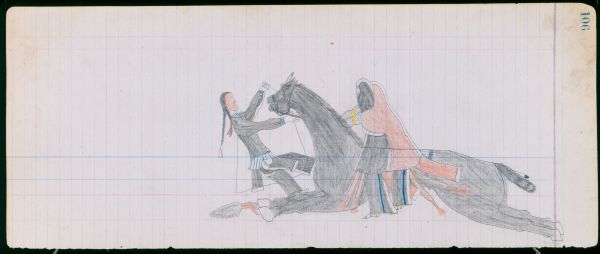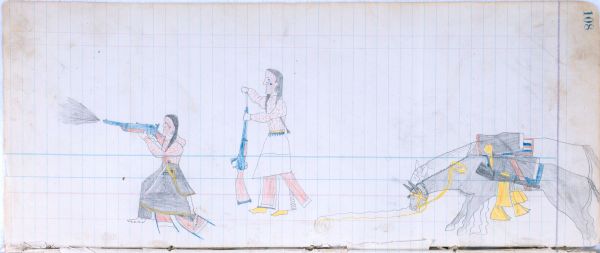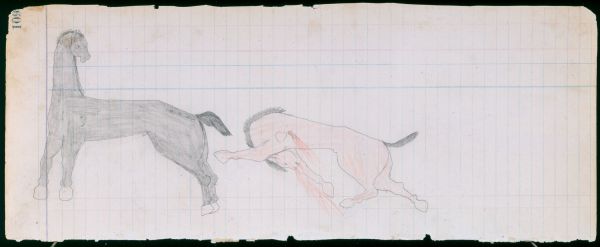PLATE 106
Ethnographic Notes
In the earliest description of Cheyennes on the Southern Plains, Edwin James noted the custom from early childhood of close friends riding together on the same animal:
"We could not...restrain a smaile...at the appearance of the naked children mounted on horses, sometimes to the number of three or four on each, fearlessly standing erect, or kneeling on their backs to catch a glimpse over the heads of the intervening multitude at the...white strangers" (James, 1823, II: 178).
Here, Arrow and his Nisson comrade are wrapped anonymously in their courting blankets, on their way to visit one or both of their sweethearts. We are meant to infer that the action is occurring in darkness. Although structurally like Plates 1, 2, 5, 7, 13, etc., the context here has nothing to do with warfare; as we understand from the fact that no weapons are shown, the horse has a nondescript headstall, and an unbound tail. Instead, this is a joking scene, perhaps an accident that occurred in the darkness; or possibly the intentional discomfiture of a rival suitor, who was shouldered aside and knocked off his feet by the trampling horse. His own courting blanket, a white wrap of light canvas or muslin sheeting, is being knocked out of his hands, and he has dropped his eagle wing fan. A moment more and his captured cavalry blouse, dark blue leggings and breechcloth will be covered in dried grass stems and dirt. The curve of the dark blanket surrounding the lead rider's face suggests the up-turned corners of a smile. One can almost hear the low chuckles as the two conspirators call back over their shoulders: "Oh, sorry---didn't see you."
The contorted posture of the rival, with his legs knocked akimbo and his buttocks revealed, is part of the humor intended by Arrow. This strange position, however, allows the artist to show in detail something rarely depicted in ledger art: the strap at the top of a legging, by which it is attached to the belt. For another example, see Wardwell, 1998: Fig. 8, upper left.
Although here Arrow has tied his small, protective feather to the tail, the horse probably belongs to his friend, since it appears to be the same, fork-earred black stallion ridden by the comrade in Plates 134 & 136. Also, the spotted eagle feather tied to the horse's forelock does not appear on any of Arrow's other horses. Arrow owns a similar black---not quite as fast, hence lacking the notch in his ears---which is the animal the two share in Plates 124 & 138.
Arrow's dark leggings with the narrow stripe of blue silk ribbon appear again in Plates 124 & 148. Both men here, however, are wearing identical leggings, beaded moccasins, red breechcloths, and even have identical yarn sashes. Although the men have different shirts, Arrow wore the red one with narrow, black stripes in Plates 80 & 86; and will wear the one with blue polka-dots in Plate 144. So we cannot be certain which of the riders is Arrow, and which is his friend. This is a good illustration of the closeness of the the Nisson relationship, wherein all possessions literally were held in common, and the identity of one relative was so intimately connected with another that they could actually meld


